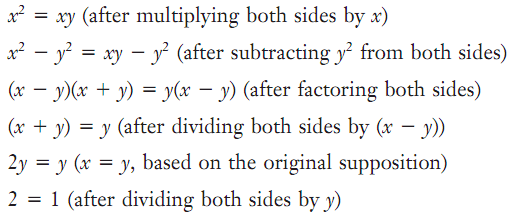
Division by Zero
 المؤلف:
Amdahl, Kenn, and Jim Loats
المؤلف:
Amdahl, Kenn, and Jim Loats
 المصدر:
Algebra Unplugged.
المصدر:
Algebra Unplugged.
 الجزء والصفحة:
...
الجزء والصفحة:
...
 11-1-2016
11-1-2016
 2848
2848
The number 0 has unique properties, including when a number is multiplied or divided by 0. Multiplying a number by 0 equals 0. For example, 256 x0 = 0. Dividing a number by 0, however, is undefined.
Why is dividing a number by 0 undefined? Suppose dividing 5 by 0 produces a number x:

From 5/0= x it follows that 0 x x must be 5. But the product of 0 and any number is always 0. Therefore, there is no number x that works, and division by 0 is undefined.
A False Proof
If division by 0 were allowed, it could be proved—falsely—that 1= 2. Suppose x =y. Using valid properties of equations, the above equation is rewritTen

This absurd result (2 =1) comes from division by 0. If x = y, dividing by (x - y) is essentially dividing by 0 because x - y =0.
Approaching Limits
It is interesting to note that dividing a number such as 5 by a series of increasingly small numbers (0.1, 0.01, 0.001, and so on) produces increasingly large numbers (50, 500, 5000, and so on). This division sequence can be written as 5/x where x approaches but never equals 0. In mathematical language, as x approaches 0, 5/x increases without limit or that 5/x approaches infinity.
______________________________________________________________________________________________
Reference
Amdahl, Kenn, and Jim Loats. Algebra Unplugged. Broomfield, CO: Clearwater Publishing Co., 1995.
Miller, Charles D., Vern E. Heeren, and E. John Hornsby, Jr. Mathematical Ideas, 9th ed. Boston: Addison-Wesley, 2001.
 الاكثر قراءة في الرياضيات العامة
الاكثر قراءة في الرياضيات العامة
 اخر الاخبار
اخر الاخبار
اخبار العتبة العباسية المقدسة


